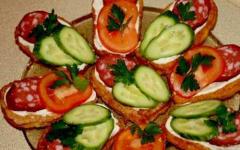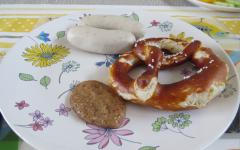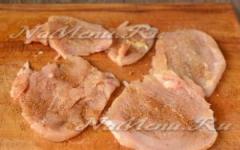In contact with
Click Class
Earlier, when we lived in Uzbekistan, with the advent of the vegetable season, we always prepared a very tasty dish Uzbek cuisine, with an interesting name damlama (dimlama). However, this dish was also called basma. I can not say with certainty why the same dish was called in different ways. Although I was interested in this issue.
Someone said that the difference still exists. Allegedly, during the preparation of the damlam, the meat is lightly fried, and when preparing basma everything is prepared in its own juice, without pre-roasting. There was also another opinion that the name depended on the place where it was prepared.
Whatever it was, I always cooked this dish called damlam. So it is called in Samarkand, where I lived. So I propose to cook it today. Moreover, the "damlam" - literally "cooked for a couple." And we will cook it for just a couple.
Damlama is a classic dish of Uzbek cuisine. Same as, or. This is the favorite dish of the Uzbek people. Cook it all season, while there are fresh vegetables. And now, when to buy fresh vegetables is not a problem all year round, then they also prepare it.
As already seen from the name of the recipe, it is prepared from vegetables and meat. And vegetables are used absolutely any. Since this dish has been prepared since ancient times, it was prepared first from meat, onions, carrots and turnips. Potatoes, eggplants, peppers and tomatoes were not in Uzbekistan at that time. It was only later that they began to be cultivated gradually.
Just gradually new vegetables began to be added to the damlam. And now this dish is very rich in vegetables. I love to cook it to the maximum, using all available seasonal vegetables. But this is by no means a dogma. You can take vegetables that you want. Their number can also be varied. From the set of products that is presented below, a full cauldron is prepared for 5-6 liters. That is somewhere in 6-7 full-fledged portions.
I have guests today, and that's why I cook a full cauldron. If you cook for a smaller number, then just reduce the number of ingredients.
There are many options for preparing damlam. Vegetables are always used for the season. And they can always be taken different. So, in the autumn period, the potato is completely replaced by a quince. Ordinary cabbage - colored. Instead of apples, apricots or other fruits are used. And in winter, when tomatoes are not so juicy, you can replace them with tomato paste. You can cook it with or without meat. And also use chicken and fish.
Preparing this dish is extremely easy. Probably hard to find yet the same, which would be easier to cook than this. Also it is necessary to give it due that despite simplicity and ease of its preparation, it turns out it is very tasty and useful.
- First, neither meat nor vegetables are fried.
- Secondly, a minimum of oil is used.
- Thirdly, everything is prepared for almost a couple.
- Fourth, the dish is quenched rather than cooked. So more vitamins and nutrients are saved.
- Fifthly, during the whole cooking, no liquid is added at all. The dish is prepared in its own juice.
That is, for certain you already wanted to cook a damlam. And right! Especially. that the stores just an abundance of vegetables. Just for our dish. Today I went to the market, and bought all the vegetables that I saw. Let's see what we will cook from today, and what will come of it.
Uzbek damlama (basma) - vegetables stewed with meat in kazan, preparation
We need:
- meat beef - 800 - 1000 gr
- onion - 3 pieces
- potatoes - 800 gr
- eggplant - 2 pieces
- zucchini - 2 pieces
- carrots - 2 pieces
- tomato - 2-3 pcs.
- bulgarian pepper - 2 - 4 pcs.
- cabbage - 400 gr
- garlic -1 head
- apples - 2 pieces
- greens - parsley, dill, basil, mint, tarragon
- spices - zira, coriander, paprika
- red pepper pepper - 0,5 - 1 pc.
- salt, black pepper powder
- vegetable oil - 50 gr
- green onion - for sprinkling

Preparation:
1. Meat for damlam you can use either beef or lamb. Since we will cook almost without oil, it is good that the meat was slightly fatty. I use a part of a brisket, it with bones and on it there are necessary fatty interlayers. And part of the tenderloin, it is boneless and without fat.

It happens that another bacon is used, which is laid by the first layer in the cauldron. It is believed that it protects the dish from burning. But I do not add a fat, I do not like the smack from it.
But if I cook from mutton, and I have fatty fat, then I certainly put a small piece. A piece of fatty fat is superfluous in such dishes never happens. But today we cook from beef and without fat.
2. My meat, let it drain off. And cut the average pieces of 6-7 cm thick.
3. Vegetables and herbs are also mine, cleaned and cooked, so as not to forget anything.
4. We pour oil into the kettle, about 1/4 of the glass. We try to get the oil on the whole surface of the wall, especially in its lower part. If you like food fatter, add a little more oil.
In general, the amount of oil depends on what fat content you use meat. It is clear that the fatter the meat, the less oil you need to add.
5. Lay the first layer of meat. If a piece with a bone, then it is better to lay it down with a stone.

6. The next layer is carrots. We cut it with circles 2 cm thick, and if it is thin, then the bars are thicker.

7. Then a layer of potatoes. We cut it larger so it does not boil. The average potatoes are cut into two parts, and the large one by 3-4. Try to keep the size and shape the same.

Potatoes lightly pressed with a hand. The same is done subsequently with each successive layer.
8. Put garlic, peeled from the outer shell, in the center. When you prepare a dish, be sure to try it. You will be surprised at how unusual his taste has become.

9. Cut the onions into half rings, 0.5 cm thick and spread out half.

10. Then the Bulgarian pepper. We cut it with large feathers. Together with him we put red capsicum. My pepper is sharp enough, and I only put half of it. If the pepper is not very sharp, then you can add a whole pod.

11. Then spread the tomatoes. They can be cut in circles, if the tomatoes are not large. And you can and slices. Someone likes tomatoes larger, and puts small tomatoes entirely, but cuts it into two pieces. The main thing is not to be too small. Someone first removes peel, someone does not. I leave her this time. Tomatoes were very thin and very ripe. Therefore, there is no need to shoot it.

12. Layer with tomatoes, salt. You can pour only half, and half later. The total amount of salt that I needed was 1 tbsp. spoon. Add spices and pepper. From the zira immediately went the strongest flavor. I slightly rubbed it in my hands, and then I sprinkled it on tomatoes.
13. We put two apples in the center. To add flavor, it is better to add sour friable apples. Good for this apples variety Semerenko. But today I saw apples of fresh harvest, and took them. To taste, they are sweet and sour.

14. The following are eggplant. Cut them in small rings with a thickness of 1.5 cm. Lay out an even layer.
15. Then - zucchini, cut in the same way.
If not salted in the middle, then add salt now.
16. With cabbage we remove three whole sheets. It's okay if they suddenly break somewhere a little. Then the remaining cabbage is cut into pieces 2-3 cm thick. We spread it with the next layer.

17. From above spread the greens and spicy herbs.

18. And we close all the whole leaves with cabbage.
Preparation and supply of damlam (basmas)

Eat while hot, and enjoy the taste of young vegetables and juicy meat, washing down with a delicious aromatic broth.
Features of preparing damlam
- damlama (basma) is cooked on a very slow fire. This allows meat and vegetables to be prepared from inside as well. Due to this vegetables are delicious, moderately soft, potatoes crumbly, and the meat is juicy.
- that we do not add water, contributes to the fact that the vegetables are not cooked, but steamed. Steamed products are undoubtedly more useful than boiled, and even more fried.

- you can cook a damlam not only with meat, but with chicken and even with fish. Do everything exactly the same as in the recipe with meat.
- vegetable layers can be changed at their own discretion
- each layer can be poured, or in the middle and in the end
- layers need to be pressed lightly. This will allow vegetables to warm up more quickly and to start up the juice.
- cut vegetables roughly the same size, so they are cooked evenly.
- the damlama is delicious and freshly prepared, and the next day it will not lose its taste
- you can eat it hot and cold
- preparing a dish in a cauldron or a thick-walled saucepan. Also now he is successfully cooked in a multivariate. This is as simple as in the cauldron.
The recipe for preparing damlam in a multivark.
1. Meat and cut into pieces 6-7 cm thick.
2. Cut the vegetables in approximately the same pieces.
3. In the bowl multivarka lay out first meat, then layers of vegetables. Layers can be done in the above sequence, but you can do it the way you want.
4. Set the timer on the "quenching" mode, and cook for 2 hours.
5. Put into a large dish in layers in the reverse order.
It is very interesting to prepare a damlamu (basma) in nature. With the smell of a fire, it turns out to be especially tasty and eaten much faster than it is prepared! The main thing is to support the fire so that the fire is small. To nothing burned and left untreated.
Prepare a damlam and at home, and in the country, and in nature! I'm sure. that once you cook, you will want to cook it again and again. Damlam will love you, as beloved by the Uzbek people from ancient times to this day.
Bon Appetit!
In contact with
Prepare a delicious, beautiful and healthy dish can and does not bother with any tricks, while spending a minimum of time.
I bring to the attention of visitors to the blog a recipe very simple in cooking, but very tasty, beautiful and a healthy dish - basma, or stewed in its own juice with vegetables.
The main idea embodied in this dish is to lay in the cold kazan meat and large-chopped vegetables, put cabbage leaves on top, for tightness, press it all with a small load and put it on a slow fire to extinguish all 1,5-2 hours. The following recipe refers to a bonfire, one dish can be perfectly prepared and on the stove.
To prepare this dish, you first need a cast-iron cauldron and:
- 1,5-2 kg of mutton (or beef). I recommend with a bone, it's very tasty.
- Inner mutton fat, mesh, or beef fat
- 1 kg of onion
- 1-3 pieces.
- 2-3 whole heads of garlic
- 1 small cabbage cabbage
- 3-5 pieces of tomatoes
- a bunch of greenery (cilantro, dill, parsley, basil - according to your taste)
1 bitter pepper
- if there is - eggplant
- salt, pepper, favorite seasonings (only one pinch)
So, we prepare:
The original is taken from
at
Another Uzbek dish that conquered me - vegetable stew in his own juice in a cauldron at the stake. On how much it's delicious - do not pass. Personally, I will only cook this dish until the end of this season. 
The bottom of the Kazan lined the inside with mutton fat, what is a mesh. You can use any available fat. Meat in large pieces. I bought lamb for three days, so to preserve it, I marinated it in spices with salt and olive oil.

Fill the meat generously with onions in a 1: 1 ratio. Add the onion to let the juice.

Next, the order and choice of vegetables does not matter. What is available - everything in Kazan! I have potatoes, carrots, bell pepper, zucchini, eggplant, tomato, cabbage, coriander, celery, basil ...
The main principle: vegetables should be cut large, otherwise they will turn into vegetable caviar, which is also not bad) Potatoes whole, carrots obliquely.
Perhaps you will not believe, but this meat literally melts in your mouth.
Delicious meat that anyone can cook!


In a cauldron or an ordinary pan, add slightly salted meat. Pour a little water - for a kilogram of meat about a glass. Cover with a lid, put on medium fire, and when the fire begins to boil off, or even put it on the dissector. Let the meat is prepared from an hour to an hour and thirty minutes - it all depends on the rigidity of the meat in its raw form.
I share the secret: if you understand that the meat is different, some pieces are tender, while others are more sinewy, hard, and even on bones, then do as I: lay the meat with a slide. Down put the bones and hard meat, if the meat is fat, then fat to the bottom, and on top put the softer pieces. Let the hard parts are in the water, and the soft parts are prepared for a couple. In this case, the lid from Tajin is very suitable, although you can do with the usual lid on which you should put a wet napkin.

While there is nothing to do, grind in a mortar of spices and salt, which should be chosen according to your taste.

I share the secret: for lamb I have not yet thought of anything better than to mix coriander, zir, salt and black pepper in the proportion of 2-1-2-1.

When the meat in the cauldron is ready, put the colander on the edge of the colander and put the meat in it - let the broth flow back. Add a fire under the fire almost to the maximum and wait until the broth is almost evaporated. Then dip the meat in pieces, sprinkle it with a mixture of spices and fry. A ruddy crust on the meat will appear very quickly, turn the meat with forceps so that it is fried from all sides and lay out on the dish you will serve.

I share the secret: what remains in the cauldron after cooking the meat is an excellent preparation for the sauce. Add a glass of good wine to Kazan, scratch the bottom with a sieve, let the proteins squeezed to the bottom dissolve. Try and, if necessary, straighten the salt. If desired, add a tablespoon of cream or thicken the sauce in other ways. If the sauce is too greasy, then simply remove the oil from the surface with a spoon or a special tube, with a pear on the other end.

At such meat only kind of fried, in practice it has absolutely other consistence. Nevertheless, onions and sumacs will approach to such meat as well as possible!
Meat with garlic and vegetables


But there is another way to prepare such meat for filing. Pour olive oil on the frying pan and lay a leek on it. Fry it on low heat, setting a task not so much zamumyanit it, how much to soften.

Add garlic, thyme and rosemary to the pan.
I share the secret: the onions could be ordinary, but large chunks, instead of thyme and rosemary, you could take a bay leaf and whole capsicum without opening it, if you do not want it spicy.

Cut the tomatoes around the equator and spread them around the edge of the frying pan, where it's cooler. In the center lay out pieces of prepared meat and fry it, sprinkling with a mixture of spices and salt.
I share the secret: so much oil in a frying pan was necessary not because I love butter, but to ensure contact between meat and a frying pan. Boiled meat is not as plastic as raw, and if the oil is low, then the meat will be immersed in oil only in places. After cooking vegetables and meat, this oil can be filtered and used, for example, for roasting potatoes - it only became more delicious, because the flavors of vegetables and meat remained in the oil. But you can not store such oil for a long time.

You can serve ready-made meat and vegetables without oil, and, if desired, with balsamic vinegar.
Lamb with onions and mint sauce

So you can cook almost any type of meat, but if someone really wants to repel the smell of mutton, then there is another way.

Salt well and pepper the meat. Rinse and dry mint and basil.

Add pieces of meat to the leaves.

Wrap the meat with an oil seal.
I share the secret: the omentum is inside every animal, from rabbit to cow. Demand it from butchers - this is a wonderful product that can be used in dozens of different dishes.

Tightly wrap the meat food film, trying to keep no air inside. Tie the ends to a knot.
I share the secret: it was possible to cover the meat not with an omentum, but with frozen yoghurt. In the usual yogurt put garlic, a lot of greens, salt, pepper, whisk blender. Lay out in a flat shape and freeze.

Place convolutions in a special film and pump out air with a vacuum pump, seal the edges.
I share the secret: just wrap the meat food film is also quite enough. Even if during the preparation of the convolution a little water will get or a little broth will come out of the package, nothing terrible will happen.

Place the meat in a container filled with hot water.

Set the cooking temperature for lamb 72C, for beef 52-58C, for pork and poultry 85C. Time of preparation select depending on the type of meat - from two to eight hours.
I share the secret: check with a thermometer what temperature in different modes your multivarkers, slow-cookers or rice cookers support. Most likely, you can use one of these modes for cooking meat in this way. And if you do not have a multivark, but have a head on your shoulders, then cook the meat on a steam or water bath, controlling the water temperature in the upper tank with a thermometer. If you do not have a vacuum packer, or if you, in captivity of delusions, do not want to use food film in hot environments, then simply lay the meat in one of the above mentioned devices, pour a glass of water and cook for several hours.

After cooking, place the packages with meat in cold water with ice, so that they cool down as soon as possible.
I share the secret: after the meat has cooled down, it can be taken to the refrigerator and stored for several days, until you get hungry.

Cut the mint and put it in the saucepan.

Cut the edge of the package and gently strain the meat juice into the mint. If it is very small, then add a little water. The liquid should not cover the mint.

Bring the contents of the saucepan to a boil, but do not boil, but remove from heat and allow to cool. Cool the infusion of mint strain.

In infusion of mint, add a spoonful of honey.

Put the heat and add lemon juice to taste. If necessary, season with salt.

Spoon the starch in three tablespoons of water and let stand. Add the starch to the sauce and heat until thickened.

I share the secret: the sauce could be thickened in other ways.

After the sauce has cooled to 50-60C, add the cut mint and basil into it, and if necessary, treat it with a blender.

Open the package with meat, discard all frozen fat, omentum and greens. Fry the meat to a crispy crust in oil or animal fat.

Fry the red sweet onions a little and discard all the oil from it.
I share the secret: the onion could not be fried, but several times scalded with boiling water.

Serve meat with onion and sauce.

When you eat, try not to get sloppy.

I share the secret: everything new.
And do not forget: this is Sunday, Dorogomilovsky market, 15:00, the premiere of the sale of my new book MANGAL. Its content is also different from the previous ones, like this article from a well-forgotten old one (see the link in the previous paragraph).
Which is very popular all over the world. There are many ways to prepare it, and in this article we will describe the most interesting.
Dumlyama. Meat with vegetables in kazan
If you want to learn how to cook a real Uzbek dish, then you should pay attention to the technology of its preparation and strictly follow the instructions. How is potatoes prepared with meat and vegetables in kazan?
- Prepare a half kilogram of beef (ribs, back or shoulder blade). It will be better if you take meat on a bone with a little fat. Cut it into small pieces.
- Heat the five-liter cossack on fire, add oil to it, and then fry the beef until golden brown. To pieces are not welded, you can cook in parts, and then reconnect them in the cauldron.
- 500 grams of white onion peel off the husks and cut into half rings. After this, lay it on the meat, cover the dishes with a lid and simmer in the smallest fire for 20 minutes.
- Peel 700 grams of carrots from the rind, thoroughly wash it, and then slice the rings obliquely. Prepared product put in the cauldron and mix with the rest of the ingredients.
- Season the dish with two teaspoons of zira. At the same time, add to the products three tomatoes, cut into half rings, and chopped Bulgarian peppers.
- Pour the dish with boiling water, dip the capsicum, two or three garlic heads whole (remove only the upper husk), one quince or a solid apple. When the water boils, reduce the heat and cook dumpling for another 40 minutes.
- While the base is being prepared, peel one or two kilograms of potatoes from the peel. It is better to choose small tubers so that you can weld them whole. Put the potatoes in the cauldron, and from above cover it with the leaves of fresh basil. Do not forget to salt the dish well.
- Close the lid with a lid, move it to the smallest cooking zone and reduce the heat to a minimum. Cook the dish for an hour and a half.
When the specified time passes, you can open the lid and get the garlic with hot pepper. Lay the meat and sauce on the plates, add a whole potato to them and serve the dish to the table. 
Meat with vegetables in a cauldron at the stake
Uzbek kazab-kebab you can cook with your own hands at the cottage and please the delicious dish of guests. To prepare meat with vegetables in a cauldron, you need to do the following:
- Take one and a half kilos of any meat and cut it into slices. Put it in a bowl and season with two large pinches of salt, two teaspoons of zira and hot pepper to taste. Leave the meat to marinate for an hour or two.
- Prepare for use round Uzbek kazan on a special stand. Please note that for cooking the dish, an ordinary bowler on the crossbar will not work. When you have built the hearth, warm the cauldron on fire.
- Put on the bottom of the casserole pieces of bacon and a few peeled potatoes that are needed to soak up excess fat and not let the meat settle on the very bottom. Around the tubers lay out pieces of meat (they should literally stick to the walls).
- Reduce the heat and cover the products with a suitable bowl. Cook this way for the next 30-40 minutes.
- When the excess moisture evaporates, and the pieces start to hiss, remove the bowl and mix the contents of the cauldron.
- Peel two large bulbs from the husks, cut them with rings, pound them with hands and wash in running water. Stir the prepared onions with a spoonful of lemon juice, hot pepper and chopped greens.
Ready to put the kazab-kebab together with the potatoes on a large dish, pour the sauce from the cauldron and decorate the pickled onions. 
Basma
Before you one more uzbek recipe. Meat with vegetables you can easily cook yourself, even if there is no great culinary experience. For this you need:
- Lining the bottom of the cauldron with mutton fat, and on top lay two kilograms of meat, cut into pieces. It is better to take mutton marinated in olive oil and spices, but beef is also suitable.
- Onions (as much as meat) are cleaned and cut into rings. After that, put it in a cauldron and salt it.
- Then you can put those vegetables that you have available. For example, whole potatoes, carrots, eggplants, peppers, zucchini and tomatoes. The order of the layers does not matter. Note that the vegetables should be cut large so that they do not turn into a mess.
- Season the dish with salt, spices, fresh herbs, basil leaves and hot pepper.
- Close the resulting construction cabbage leaves and put the cauldron on fire. Pressurize the contents with a sealed lid or bowl, and install the load on top.
In two hours, a delicious dish will be ready. 
Shish kebab in kazan
In practice, another traditional Uzbek recipe. Meat with vegetables can be prepared in such an interesting way:
- Kilogram of mutton, cut into small pieces and salt.
- 300 grams of white onion peel and cut into rings. After this, transfer it to a bowl and mix with cilantro or dill.
- Put the meat and onions mixture alternately (in several layers) into the kazan. Make sure that the products are laid not less than the middle and not higher than two fingers.
- Add the penultimate layer to the half of the pod hot pepper or ground hot pepper.
- Close the lid tightly and put it on a small fire.
After three hours, the shish kebab will be ready, it can be served to a table with pickled onions. 
Kuyrdak
How to cook in a cauldron?
- Peel and chop 150 grams of onions.
- 400 grams of fattened fat cut into a cube.
- 400 grams of offal (lung, liver or heart) wash, cut into strips and fry on fat for 20 minutes.
- 600 grams of potatoes cut into small slices. And then lay it on meat, season with salt and pepper. Pour the products with water (about 200 ml) and cook over low heat under the lid for another half hour.
When the meat with vegetables in the cauldron is ready, you can immediately submit it to the table.
Conclusion
As you can see, all the recipes are simple enough. Meat with vegetables in a cauldron can cook everyone. Read our recipes and surprise loved ones with original dishes!









